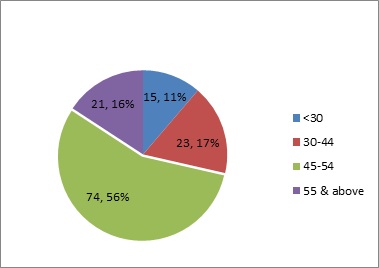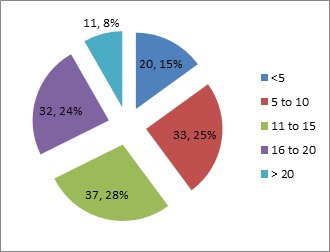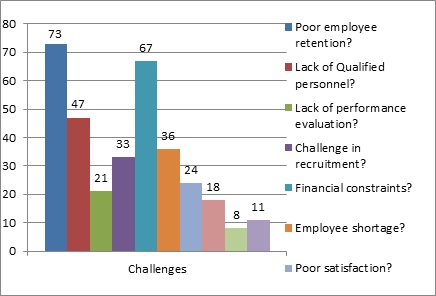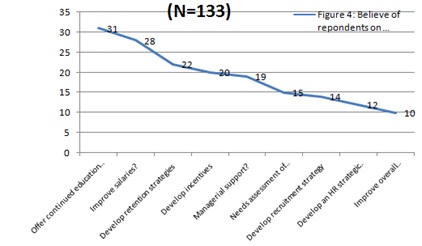
Exploring Human Resource Management in the Health Care Systems of Pakistan
*Corresponding Author(s):
Mishal LDepartment Of Nursing, Nursing Instructor, University Of Lahore, Pakistan
Tel:+03441481666,
Email:mishee861@gmail.com
Abstract
Background
Human resource management is an integrated strategy that uses an integrated approach for employment, enlargement, and security of employees working in a certain organization. Thus, the probability of survival of organization becomes high and attainment of intended objectives is easy when managed and staffed by well-built and encouraged staff.
Objective
This study aims to explore the practices, strategies, challenges, and outcomes of persons working in human resource management departments of different public or private hospitals of Pakistan.
Materials and Methods
This cross-sectional study was undertaken in the Department of Nursing, The University of Lahore in collaboration with 61 public and private hospitals of Punjab, Pakistan fromSeptember 2019 to April 2020.A total of 133 managers were included in the final analysis.Data was entered and analyzed by using the latest version of the statistical package for social sciences (SPSS) 25. Qualitative variables like gender, important challenges, and strategies, etc. were presented as frequency and percentage while quantitative variables including age and experience were presented as mean±standard deviation.
Results
Most of the prevalent challenge reported to be 73(54.9%) respondents was poor retention of employees followed by 67(50.4%) was financial constraints. A total of only 31 (23.3%) reported that organizations offer continued education and training programs, 28 (21.0%) believe that organization has a focus on improving the salaries, 22(16.6%) think the strategies for employee retention are developing.Most 75.9% of respondents reported that performance appraisals are conducted yearly while 24.1% reported that performance appraisals are not documented in their hospitals but few staff members are appraised based on verbal reports. Around 61.7% responded about periodic assessments of credentials while only 39.8% of health facilities are reported to promote continuing education for the career development of employees in their organizations.
Conclusion
Hospitals of Pakistan need to enhance the competencies in existing models of human resource management to strengthen the institutions for the provision of quality services. There is a great need to benchmark the competent framework from the developed world with the acquisition of skills, knowledge, attitudes, and nice working atmospheres.
Keywords
Employees; Hospital; Human resource management; quality services.
INTRODUCTION
One of the major challenges for healthcare organizations is the availability of capable, motivated, and strong workforce nowadays while people-driven health organizations bear labor costs as their primary expenses. According to the World Health Organization (WHO), there will be a shortfall of around 18 million healthcare workers in low and middle-income countries until 2030 (Boniol et al., 2019). United Nations have established well-determined targets being laid by sustainable development goals (SDGs) for the well-being of people, controlling the diseases, provision of health equity, and providing universal health coverage (UHC) till 2030.
Functions of any health organization are mainly mediated by healthcare workers who perform a major role in the achievement of targets while the system is extremely rigorous in manpower. On the other hand, the effectiveness of the healthcare delivery system is dependent on devouring a team of healthcare workers with appropriate mix to ensure the desired numbers of each specialty, inspiration towards given assignments, and ability to achieve the tasks [1-3]. Comprehensive Human resource management (HRM) practices are an important strategy to retain health professionals effectively in healthcare organizations. Turnover in retaining and recruitment reality of healthcare professionals’ workforce, as well as other responsibilities, are dependent on the performance of human resource managers which could not be underestimated in this era of the 21st century [4,5]. It has been around more than a decade ago when few developing and most of the developed countries situated in the Middle East realized healthcare human resource is as much necessary as consumables and physical capital for the proper functioning of the organization [6]. Further studies have approved that there is a strong association between health outcomes of the population and the proportion of healthcare professionals in the system [7]. Efforts to upgrade healthcare service for the achievement of universal health coverage are being made in various low & middle-income countries where achievement of these objectives are antagonized by serious shortfall and unequal distribution of skillful healthcare workers who present a mandatory constriction to deliver necessary health services [8]. These underdeveloped countries are facing human resource crises in health due to many reasons; primarily due to lack of qualified health professionals, secondly poor distribution of required healthcare workers, and thirdly lack of performance appraisals related to productivity and quality of provided services [9]. Various factors have been reported to be contributed to this problem consisting of insufficient training capacity & education, inappropriate work atmosphere, poor regulation of HRM, and derisory financial or non-financial enticements [10]. International interventions showed their concerns to motivate national stakeholders and researchers of each country to note the upcoming shortfall due to mal-distribution of healthcare workers while governments have responded to address the issues for achieving universal health coverage [11].
Most of the Middle East and South Asian hospitals including Pakistan have poor work atmospheres due to a lack of a comprehensive recruitment system and workforce retaining practices. Pakistan has a lower human development indicator (HDI) value of 0.56 as compared to the overall HDI value of South Asia as 0.642, India as 0.647, and Bangladesh as 0.614. Thus, the reasons behind poor services include a surging shortfall of trained staff, poor satisfaction of employees, early retirement, and high turnover among organizations. Similarly, various healthcare providers lack managerial and planning capacity in HRM while essential strategies like job satisfaction, planning, and workforce retention are ignored.
AIM OF THE STUDY
This study aims to explore the practices, strategies, challenges, and outcomes of persons working in human resource management departments of different public or private hospitals of Lahore, Punjab, Pakistan.
MATERIALS AND METHODS
It was a Cross Sectional Survey conducted at the department of nursing, The University of Lahore in collaboration with various public and private hospitals of Punjab, Pakistan from September 2019 to April 2020.A sample size of 129 respondents was calculated by taking confidence level as 95%, precision level as 7%, and the expected value of successful strategies by respondents as 79.4%. A non-probability convenient sampling technique was used to conduct data. Stratification of hospitals was done as 25-100 beds, 101-200 beds, and >200 beds to avoid the bias, and hospitals were included belong to either public or private sector. Hospitals lacking the HRM department and run on the owner’s dictation only or having <25 beds capacity were not included in the present survey. The present survey targeted employees, managers, and staff having a combined role with HRM departments of various hospitals. A predesigned questionnaire based on an extensive literature review which was discussed and approved by the senior faculty board was used to collect the information. Various open-ended and close-ended questions were documented in easy and understandable manners. The questionnaire comprised of age, gender, education, specialty, role, and specific training details of respondents. Various challenges at an organizational level including retention of employees, availability of specialized healthcare staff, recruitment issues and financial constraints, etc. were asked. Similarly, strategies undertaken for batter services and improvements in the HRM system were also asked as open-ended questions and therefore were easy to respond.
Different categories of the workforce under HRM facing various challenges and methods of coping with issues were also asked including assessment trends of employees, frequency of appraisals from health staff especially nurses. Further up-gradation through continued education and personal development programs were also explored. Although Urdu is the National Language of Pakistan most of the health staff use English as an official language and all understand this language in letter and spirit therefore questionnaire was also developed in this language. After finalizing the questionnaire, it was tested as pilot work in the hospital attached to the University resulted in the adaptation of minor changes. Data was entered and analyzed by using the latest version of the statistical package for social sciences (SPSS). Qualitative variables like gender, important challenges, and strategies, etc. were presented as frequency and percentage while quantitative variables including age and experience were presented as mean±standard deviation (SD). Chi-square test was applied to compare the proportions where applicable like in gender and p-value <0.05 will be considered as significant.
RESULTS
A total of 145 human resource managers were contacted in around 61 hospitals of which 28(45.9%) were private sector and the remaining 33(54.1%) were public sector hospitals. Around 12 (8.3%) respondents failed to respond properly and were not included in the final analysis while the remaining 133 managers were included in the final analysis. The mean age of respondents was remained to be 46.2±10.1 years. Various age groups of respondents are presented in (Figure 1). Most of the managers (56%) were in the age group of 45-54 while the least (11%) were in the age group of fewer than 30 years of age. The male gender presenting 71.4% proportion in the present study remained pre-dominant as compared to females (28.6%) in this study and the difference was remained to be significant (p-value <0.0001). Few (3%) HRM had a lowest educational level, however,have had a great experience not only in the field but in specific healthcare facility also but all of them were working in the private health sector and none of them was atheist management level. As many as, 59.4% of HRM were specialized and qualified in the field of hospital management. Qualifications and descriptions of respondents are shown in Table 1.
|
Question |
Response |
n |
% |
|
Gender |
male |
95 |
71.4 |
|
|
Female |
38 |
28.6 |
|
Are you individual In-charge of the HR department at your hospital? |
Yes |
88 |
66.2 |
|
|
No |
45 |
33.8 |
|
If yes to Q1, do you hold another position as well? |
Yes |
28 |
31.8 |
|
|
No |
60 |
68.2 |
|
What is your Highest Education? |
High School |
4 |
3 |
|
|
BBA/BSN |
57 |
42.9 |
|
|
MBA |
34 |
25.6 |
|
|
MPH |
28 |
21 |
|
|
MD |
10 |
7.5 |
|
Are you specialized/qualified in HRM? |
Yes |
79 |
59.4 |
|
|
No |
54 |
40.6 |
|
Are you interested in pursuing training/education in HRM? |
Yes |
99 |
74.4 |
|
|
No |
34 |
25.6 |
|
Did you attend workshops on HRM over the past 3 years? |
Yes |
70 |
52.6 |
|
|
No |
63 |
47.4 |
|
Have you previously worked in the HRM field? |
Yes |
81 |
60.9 |
|
|
No |
52 |
39.1 |
Table 1: Qualifications and Description of Respondents. (N=133)
 Figure 1: Age Groups of HR Managers
Figure 1: Age Groups of HR Managers
Only a few 11 (8%) HRM had hospital job experience of more than 20 years followed by 20 (15%) had the least experience of fewer than five years while the rest of the three experience groups had almost similar proportions as shown in (Figure 2).
Various challenges were present in each organization depending upon the provided situations. Most of the prevalent challenge reported to be 73(54.9%) respondents was poor retention of employees followed by 67(50.4%) was financial constraints. At the secondary level lack of qualified staff, shortage of employees, and challenges in recruitment was proposed by 47 (35.4%), 36 (27.1%), and 33 (24.8%) respondents respectively. Least respondents were unsatisfied with the capacity of human resources as 11 (8.3%) and strategic planning as 8 (6.0%) as shown in (Figure 3). Among 73 respondents supposed poor retention policies were again pursued whether strategies included will remain successful or not and 60 (82.2%) agreed to while the remaining 13 (17.8%) were disagree with strategies.
 Figure 2: Working Experience in Hospital (in Years)
Figure 2: Working Experience in Hospital (in Years)
 Figure 3: Frequency of different challenges in HRM (n=133)
Figure 3: Frequency of different challenges in HRM (n=133)
Believe of HRM respondents on various strategies were also noted and an overall unsatisfactory picture was obtained. A total of only 31 (23.3%) reported that organization offer continued education and training programs,28 (21.0%) believe that organization has a focus on improving the salaries, 22(16.6%) think the strategies for employee retention are developing, 20 (15.0%) believe in the provision of incentives, 19 (14.3%) think they provide managerial support to the patients, 15 (11.3%) think that there is need to assess challenges again, 14 (10.5%) are working to develop recruitment policies, 12 (9.0%) are focused on developing HR strategy and 10 (7.5%) desire to improve the overall environment of the organization.
Various factors regarding enabling the HRM to foster the employees from switching the jobs and learning strategies were also inquired from respondents. Most 75.9% of respondents reported that performance appraisals are conducted yearly while a big proportion of 24.1% reported that performance appraisals are not documented in their hospitals but few staff members are appraised based on verbal reports. Around 61.7% responded about periodic assessments of credentials while only 39.8% of health facilities are reported to promote continuing education for the career development of employees in their organizations (Figure 4). On asking about regular training sessions, 70.7% of respondents reported that they had periodic training sessions within and outside the hospitals whereas 51.9% thought that more training is required to improve their skills while only 34.6% were in the view that the facility has employee retention strategy Table 2.
 Figure 4: Believe of respondents on Strategies
Figure 4: Believe of respondents on Strategies
|
Question |
Response |
n |
% |
|
Does the hospital conduct performance appraisal for all staff members on regular basis? |
Yes |
101 |
75.9 |
|
|
No |
32 |
24.1 |
|
Does the hospital conduct a periodic assessment of the credentialing of medical and nursing staff? |
Yes |
82 |
61.7 |
|
|
No |
51 |
38.4 |
|
Does the hospital have a continuing education or career development program for employees? |
Yes |
53 |
39.8 |
|
|
No |
80 |
60.1 |
|
Does the hospital hold regular training sessions for staff? |
Yes |
94 |
70.7 |
|
|
No |
39 |
29.3 |
|
Does the hospital require training on specific skills in HR management? |
Yes |
69 |
51.9 |
|
|
No |
64 |
48.1 |
|
Does the hospital have a recruitment and retention strategy? |
Yes |
46 |
34.6 |
|
|
No |
87 |
65.4 |
Table 2: Trends of HRM in Participating Hospitals
DISCUSSION
Batter management of any organization is mainly dependent on its capacity building and retention of hardworking, smart, and skillful workers are the strength of hospitals. The findings of the present study are not in agreement with the above-mentioned phenomenon and various lacking are noticed. The most important portions of the present study could be observed thematic analysis of challenges and strategies where the outcome of challenges is bigger as compared to scarce strategies being undertaken to probe them. Most of the prevalent challenge in the present study was reported to be poor retention of employees as 54.9% followed by financial constraints 50.4%. At the secondary level lack of qualified staff, shortage of employees, and challenges in recruitment was proposed by 35.4%, 27.1%, and 24.8% respondents respectively. The utmost conspicuous findings showed a great mismatch among strategies and challenges in the present study is following a previous study in few parameters while a vast difference is observed in other parameters. Employee retention was observed as the main challenge by HRM respondents while only 16.6% of the same defendants showed satisfactory strategic planning in organizations which is awful.Muir and Li in 2014 divided employee retention and turnover into two major categories of factors including collective turnover factors and individual turnover factors. Collective turnover factors consist of internal mobility, a strong commitment to HRM, and selection of staff whereas individual factors include demographic gaps (like gender, age groups, distance, minorities, etc.), job-related differences (Level & performance on job), batter opportunities, extrinsic factors, job satisfaction, organizational commitment & justice, prestige in the system [12,13]. It is not necessary whether managers do not aware of standard operating procedures to address the issues as reported while there may be limited authority or capacity to alleviate challenges that are hampering the development of HRM at their level. The state of the actual challenge has been swapped as reported by few respondents in another study.
Effective strategic planning of HRM is necessary to cope with upcoming challenges and enhance communication in the healthcare system whereas lack of strategic planning is another flaw and only 9.0% of managers showed their concern in this regard presently. A study on training of hospital managers for strategic planning and management reported that 81% had a poor understanding and had a compromised understanding of strategic planning before training. After getting training in strategic positioning, the exterior atmosphere and quality of care remained outcomes of learning predictors. Strategic proposals including vision, mission, action plan, and strategic objectives of the healthcare system were sought and a significant difference in approach was observed, thus concluded that the training enhanced decision making of HRM teams according to the institution’s requirement among competitive facilities [14].
Presently 23.3% of respondents reported the facility to promote continuing education for the career development of employees exists in their organizations, 70.7% of respondents reported that they had periodic/regular training sessions within and outside the hospitals whereas 51.9% thought that more training is required to improve their skills while only 34.6% were in the view that the facility has employee retention strategy. Various organizations offer continuing education in documents but do not implement in letter and spirit whereas continuing education has great significance and acts as a ladder in professional clinical career building, productivity-improving, and enhance the image of the organization also [15]. Continuing education is the provision of non-financial incentive that allows the employees to advance their career while they may be bound to stay in the organization for a certain period after completion is another way of retention of the workforce.
Financial reward is another approach for retention of staff and reported to be 21.0% in this study however impact of such incentives is reported to be limited despite appealing due to the associated capacity of the employee, working conditions, and level of motivation from HRM. Financial constraints were reported to be 50.4% presently is much higher as compared to 24.7% reported in a similar kind of study is another reason due to which organizations fail to compensate employees presently. Reports also prevail that those financial and non-financial incentives are neither classified nor specified but favored grace of HRM.
Responsibilities of HRM are not limited to mentoring, coaching, or monitoring of staff but, must be cited as an operational tool to advance the motivation of employees [16,17]. Force, in his study, bound a particular role of managers as leaders who can encourage building an environment of shared governance, autonomy, powers, and group sutures for batter performance and mindset of stay in a particular organization. Although 34.6% of managers presently reported retention strategy as a trend of hospital HRM only 9.0% think this strategy must exist in an organization for the betterment and uplifting of institutions. There may be the chances that some hospitals retain the core of their main players in every department and believe in turnover which may benefit them to introduce younger employees on low wages instead of seniors with high wages for the same work.
Performance appraisals were reported by 75.9% of respondents yearly while a big proportion of 24.1% reported that performance appraisals are not documented in their hospitals but few staff members are appraised based on verbal reports. Around 61.7% responded about periodic assessments of credentials while only 39.8% of health facilities are reported to promote continuing education for the career development of employees in their organizations. Appraisals and credentials of employees are very much necessary to observe the performance and identification are mandatory for a security issue in a country like Pakistan. In the public sector, annual appraisals are necessary but in the private sector, it depends upon the size of the organization. Small hospitals with limited staff are not bothering about appraisals and credentials while as soon as the facility grows its business both become the part of it slowly and steadily. Perhaps a lack of evidence on the verge of appraisal compliance in hospitals by proposed standards is not understood in Pakistan yet despitethe presence of guidelines [18].
Criteria for the success of strategic plans undertaken by various organizations to mitigate the current challenges successfully are also unclear as reported by various respondents. On similar findings, a study has proposed it as an indirect outcome of knowledge as respondents belonged to HRM and responsible for the condition in their capacity(El-Jardali et al., 2009). Male gender presently 71.4% remained pre-dominant as compared to females (28.6%) in this study and the difference was remained to be significant (p-value <0.05) in HRM of healthcare facilities. Various aspects of gender equity were studied in a recent review on HRM and underlined various efforts in development, planning, and significance of gender equity at the system level however issue has been reported to be more common in physicians of developing countries.
CONCLUSION
A strong HRM in any health organization means the provision of quality services to meet the minimum required international criteria. Hospitals of Pakistan need to enhance the competencies in existing models of HRM to strengthen the institutions for the provision of quality services.Whereas few HRM personals have been notified of having an additional charge which results to compromise the quality of services. Alike above strategies for the retention of core employees must be practiced to hold the smart and hardworking class at reasonable monetary concerns. Incentives must also be distributed rightfully instead of favoritism.
REFERENCES
- Anand S, Barnighausen T (2012) Health workers at the core of the health system: framework and research issues. Health policy 105: 185-191.
- Boniol M, McIsaac M, Xu L, Wuliji T, DialloK, et al. (2019) Gender equity in the health workforce: analysis of 104 countries.
- Dussault G, Dubois CA (2003) Human resources for health policies: a critical component in health policies. Hum Resour Health 1: 1-3.
- El-JardaliF, Tchaghchagian V, Jamal D (2009) Assessment of human resources management practices in Lebanese hospitals. World Hosp Health Serv 7: 23-28.
- El Arnaout N, Chehab RF, Rafii B, Alameddine M (2019) Gender equity in planning, development and management of human resources for health: a scoping review. Human Resources of Health 17: 1-52.
- Kabene SM, Orchard C, Howard JM, Soriano MA, Leduc R (2006) The importance of human resources management in health care: a global context. Hum Resour Health 4: 20.
- El-Jardali F, Jamal D, Abdallah A, Kassak K (2007) Human resources for health planning and management in the Eastern Mediterranean region: facts, gaps and forward thinking for research and policy. Hum Resour Health 5: 5-9.
- ScheilAdlung XJ (2013) Health workforce benchmarks for universal health coverage and sustainable development. Bull World Health Organ 91: 888.
- McPake B, Maeda A, Araujo EC, Lemiere C, El Maghraby A, et al (2013) Why do health labour market forces matter? Bulletin of the World Health Organisation 91: 841-846.
- Jimba M, Cometto G, Yamamoto T, Shiao L, Huicho L (2010) Health workforce: the critical pathway to universal health coverage: fostering equity and effective coverage. Bull World Health Organ 91: 853-863.
- Kinfu Y, Dal Poz MR, Mercer H, Evans DB (2009) The health worker shortage in Africa: are enough physicians and nurses being trained? Bull World Health Organ 87: 225-230.
- Muir MR, Li L (2014) What are the top factors that drive employee retention and are there demographic (gender, generation, ethnicity, geography, etc.) differences in these factors?. Cornell university Library.
- Nations U (2015) Transforming Our World: the 2030 Agenda for Sustainable Development. General Assembley 70 Session.
- TerzicSupic Z, BjegovicMikanovic V, Vukovic D, SantricMilicevic M, Marinkovic J (2015) Training hospital managers for strategic planning and management: a prospective study. BMC Med Educ 15: 25.
- Pallas L, Duffield C, Hayes LJ (2006) Do we really understand how to retain nurses? J Nurs Manag 14: 262-270.
- Force MV (2005) The relationship between effective nurse managers and nursing retention. J Nurs Adm 35: 336-341.
- Hussain WJ (2019) Healthcare Quality Management System in Pakistan. The International Journal of Frontier Sciences 3: 74-77.
- ACR Instructions (2018) about annual confidential reports.
Citation: Mishal L, Rabia B , Iram L ,Rizwan LA (2020) Exploring Human Resource Management in the Health Care Systems of Pakistan. J Pract Prof Nurs 4: 018.
Copyright: © 2020 Mishal L, et al. This is an open-access article distributed under the terms of the Creative Commons Attribution License, which permits unrestricted use, distribution, and reproduction in any medium, provided the original author and source are credited.

